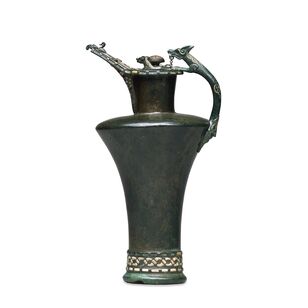
Identification[]
This beautifully detailed artifact hails from what is now Lorraine, France. It is one of a set and was constructed during the Iron Age at approximately 450 BC. At this time, most of Western Europe was under Celtic influence and artistically this resulted in La Tène Art . This particular flagon was most likely used for pouring drinks at meals and feasts. The decoration and style draws heavily on interaction and trade with the various civilizations they bordered, and this shows in the intricate details in the design.
Technical Evaluation[]
For the body of the flagon, as well as the feet, a copper/tin alloy was used [See Koch, 2006 185]. A single sheet of the alloy was beaten and burnished into the flagon, while smaller pieces were used to hold the coral and the glass in place in the decorative areas of the flagons. The rest of the elements of the flagons, including the animals, were all formed out of a leaded tin-bronze combination. The decorative inlay is made of coral from theMediterranean coast . It has faded to white, but that merely enhances the contrast between it and the inlaid red glass, which can most likely trace its roots back to Asia. During its use as a jug, the flagon's stopper had to be reattached and a new chain was added to secure it to the body.The flagons journey to placement inside of a museum began with their illegal recovery from a gravesite [See Koch, 2006 184]. The flagons changed hands many times, from one unscrupulous seller to another, throughout France with many buyers forging papers in order to raise the value. At some point one of the flagons even received damage that was repaired with a soldered piece of metal before its final sale to the British Museum in 1973 [See Koch, 2006 186].
Local Historical Context[]
Present day France was dominated by a group known as the Gauls who were members of the larger group known as the Celts . They were tribal people who spread far and wide over Europe in a cycle of migration, raiding, and settlement. The Gaul way of life was similar to that of tribes and societies all over the world. Families were patriarchal, and religious figures were set apart and above the rest of society. These religious figures, or Druids, acted not only as priests, but also as judges and doctors. In Celtic society, the social hierarchy was as simple as king, warrior, freemen. Druids were pulled from warrior families and maintained a status above that of a warrior [See Creighton, 3]. It was probably in the grave of either a Druid or a warrior that the flagons rested. Unfortunately, since the excavation was illegally performed by amateurs instead of actual archaeologists, there can only be speculation as to who was buried in the grave, with what other objects, and why. Since it is one of a set, one can infer that they were commissioned as such, and the ability to order not one but two of these heavily decorated flagons supports the theory that the owner was someone of importance as well as obvious wealth.
World Historical Significance[]
The flagons themselves are prime examples of a cultural mesh. Both the supplies and the styles come from outside influences . The Mediterranean coast provided the coral, while Asia Minor most likely supplied the red glass. The style of the flagons is taken from the outside sources and given a local twist. The handles which have a bit of an oriental flair, are in the shape of a wolf or dog. However that idea was extracted from Etruscan or Greek art. A close look at the spouts exposes a palmette decoration that is quite popular in Celtic art. Again, this motif, however popular in Celtic art, was originally found in Egypt and Greece. The decorative aspect that was wholly native to that area was that of the duck on the end of the spout. For centuries, the Celts traded primarily with the Greeks, depending on them for luxury goods like bronze. However, a change came about in the relationship between Gaul and Rome. There's no document or treaty, but a large increase in trade between the two, as well as a influx of Etruscan influence, points to an agreement of some sort [See Ebel 10]. This trade centered on settlements established near the Rhine and spread from there. Although major differences existed between the germanic tribes running amok in europe for centuries, connection to the trade routes brought not only new goods but also ideas that would help to later unify these tribes as they took on the dying Roman Empire.
Bibliography
"Basse Yutz Flagons › The British Museum." The British Museum › Welcome to the British Museum. http://www.britishmuseum.org/explore/highlights/highlight_objects/pe_prb/b/basse_yutz_flagons.aspx (accessed April 21, 2011).
"Celt (people) -- Britannica Online Encyclopedia." Encyclopedia - Britannica Online Encyclopedia. http://www.britannica.com/EBchecked/topic/101704/Celt (accessed April 21, 2011).
Creighton, Louise. A first history of France, . London: Longmans, Green and Co., 1893.
Ebel, Charles. Transalpine Gaul: the emergence of a Roman province. Leiden: E. J. Brill, 1976.
Koch, John T.. Celtic culture: a historical encyclopedia. Santa Barbara, Calif.: ABC-CLIO, 2006.